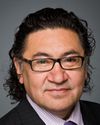[Witness speaks in Cree]
Good morning. On behalf of the 30 northern Manitoba first nations representing nearly two-thirds of the province and the over 72,000 people in the MKO territory, I would like to thank everyone for this opportunity to make this brief presentation on suicides and the crisis among our indigenous people and communities.
It is with a solemn spirit that I appear before you on this committee today as a representative of northern first nations in Manitoba. I am mindful of the pain and the loss that suicide has caused within the communities that I have been elected to represent. I am humbled by the resilience and the hope that sustain our communities throughout these periods of loss. It is this time of hope and resiliency that has historically sustained us here on Turtle Island for time immemorial.
This committee has already heard from a number of first nations, Inuit, Métis people, and organizations on this difficult tragedy. The many different viewpoints and recommendations that have been presented remind all of us of the impacts of suicide. The impacts go far beyond individuals and their families. This affects our whole community and our regions.
It is my sincere hope that our discussion on the subject will, in the spirit of reconciliation, facilitate a collaborative, fervent, and honest effort towards ending this Canadian crisis.
Suicide within indigenous communities is a complex and multi-faceted phenomenon. Suicide is linked with historical and intergenerational trauma, displacement, and the process of colonization. Last week, Quebec coroner Bernard Lefrançois released his report on five suicides at an Innu reserve in northern Quebec. He stated that the fundamental problem lies with what he called the “apartheid system” into which indigenous people have been thrust for 150 years and more. This decision is one more reason why many of us are leery of the Canada 150 celebrations.
Suicide rates are linked to the socio-economic status of first nations people and to their health status, as well as the overall disparity in the quality of life of first nations people compared with that of the general Canadian population. The deplorable rates of poverty on reserves, the shortage of housing, and the disparity of funding for education and child welfare all are documented and have been increasingly well known among the general population of this country. We applaud all efforts and commitments of governments to address these challenges, but it's understandably frustrating and very slow.
In our belief, everyone is important and every life is precious to us. We recognize that each and every one of us has the potential to be a leader and that everyone can make a contribution if they are given the opportunity. We continue to honour the memory of our youth and our family and community members who have gone before us, rededicating ourselves—myself—to protect and guide our youth, families, and communities.
It is very important that we establish long-term and lasting programs for our youth in our first nations communities. Our languages, traditions, beliefs, and ceremonies bring us together as indigenous people. By speaking our languages, practising our traditions, and maintaining our connection to our traditional lands, we become stronger as nations. As indigenous people of northern Manitoba, we must continue to take care of our families, communities, and ancestral lands, as we have done for thousands of years.
MKO first nations have looked to ways in which we can become stronger. MKO first nations are actively planning together for the future and the potential opportunities coming to our territory. We plan together for the future while honouring our youth, elders, and communities. We always recognize that our youth are the future leaders.
Following the release of the calls to action of the Truth and Reconciliation Commission of Canada, there has been much talk about reconciliation between Canada and the indigenous people. We talked about it last year, and I believe it's time to act on it this year. In the absence of an accurate and standardized curriculum regarding Canada's indigenous history, the average Canadian must base their views on outdated and inaccurate information.
A citizen in an MKO community is five times more likely to complete a suicide than any other Manitoba citizen. Youth within our region experience a high rate of suicide ideation, as well as a higher rate of suicide attempts and completion. Each time a life is lost, it is a loss for the entire family and for the communities, as well as for Canada.
In September 2015, when I was elected the grand chief of MKO, I took the responsibility of this position very seriously. I know all too well the struggles that so many of our communities face. It's for this reason that in May I released a 10-point economic action plan, reaching out to all government levels and the private sector to work with us. It is as much about the better use of existing government financing as it is about increases to such funding.
Our goal is to create opportunities and employment in our communities. We believe that in fostering hope and belief in self-determination we can make great progress in advancing our communities and reversing some of the alienation and sense of hopelessness that challenge so many youth.
I'm pleased to say to you that our message is being heard by governments and the private sector. We are seeing new partnerships that can help bring about the necessary changes that we're all asking for, that we're all seeking, and that we will work towards.
Last month, the Conference Board of Canada released a report entitled “Maximizing Manitoba's Potential”. I have a copy here. I can distribute it if need be. The report was quite clear and focused. Its conclusion was stark, and in our view, very positive. It says that indigenous people are currently vastly under-represented in Manitoba's labour market, and that Manitoba's indigenous population represents a unique demographic advantage for the province. It says that mobilizing indigenous youth into the labour force will be critical in sustaining economic growth for the province.
Not surprisingly, I am promoting this message with every business person I meet. This message is of course equally important for governments, both federal and provincial, which must work to ensure our youth get the opportunities they have been denied in the past.
MKO is promoting well-being in our territory as we speak. We've launched the “Live Different” ice road tour that's going through our communities right now, to 50 northern first nations. In education, we are currently engaging parents in 19 communities with regional meetings on their priorities. The results will be shared with the chiefs and the federal government. Also, two of our first nations recently signed on to education self-government with INAC.
This year, FNIHB and Health Canada approached MKO as the first nation entity to establish a coordinated model of mental health services for the Manitoba region, including the delivery of mental health services to all 64 first nations. MKO has been given the responsibility and the challenge to meet the mental health needs of Manitoba's first nations population under a set contribution agreement with a condensed framework. We are pleased that, despite restrictions, which are embedded in the funding agreement, we stand before you with a plan. The plan includes training and skill development for first nations in Manitoba. It will include crisis response mechanisms for northern and southern first nations, and will identify the best practices of existing services.
In closing, I would like to reiterate that indigenous suicide is a Canadian crisis. We require an honest appraisal of history in order to move toward reconciliation, which will enable effective partnerships to this end. I'm also hopeful that the Canadian sense of justice and the resiliency of indigenous people will prevail. As well, I'm hopeful that this will translate into increased meaningful partnerships and a concerted effort by all levels of government—of all stripes—and the private sector to end the crisis of indigenous suicide.
That was the formal part of my presentation.
The informal part of my presentation is that I'm here because of this man in this photo. He is my cousin. His name is Gabe. I was working here on Monday and talking about these very things with different government departments and the two ministers, Minister Bennett and Minister Philpott. I talked to them about the health transformation and how we need to relook at how we deliver programs in our communities.
We've come up with a plan. We know what works. We need to have our voice in the transformational changes that need to occur in our communities. We don't need to leave our communities. Our people love where they come from and where they live. We want to stay. We want to make it work. We know what works, and we know what doesn't work.
Unfortunately, this week as I was working, the system that is set up right now in our communities has not worked for my cousin Gabe and others who've felt that they have given up. As I was meeting, I was getting texts from my family saying to pray, but I didn't know what to pray for, and at the end of the meeting, on my way up to Parliament Hill, I talked to my dad, and my whole family was wailing, saying my beautiful cousin had passed away.
He's not a nobody. He went for training just two or three months ago for heavy duty mechanic and operation. He completed it. He has three kids. He has a wife who is in nursing. He took his family away from the community, but they didn't like living in Thompson, so they went back to our community, Oxford House, and that's where he gave up. How is a young man, a young father, and a young husband supposed to feel when they don't have any jobs to provide for their family?
Our young people feel the same way. Our young people are desperate. They have so many beautiful talents and beautiful gifts that the world needs to see, and that the kids and families need to realize.
I do not want this trip to be in vain. I wanted to go home right after I heard. I wanted to turn around, go to the airport, and just leave from where I was, but I couldn't. My family said I had to stay to do this. My community leaders said I had to stay to do this. I am doing this because of Gabe, to let you know that this is a real issue. It's not an issue on paper. It's not a statistical issue.
This is happening to real and beautiful people. It affects whole communities. On average, non-indigenous people go to maybe eight to 10 funerals in their lifetimes. We've gone to maybe hundreds. How is it fair that in this country of rich lands and resources our people have to go through this? We're in a constant state of crisis and trauma. It's not fair. We have to change our approach and our attitudes, and the conditions of our indigenous people.
[Witness speaks in Cree]





